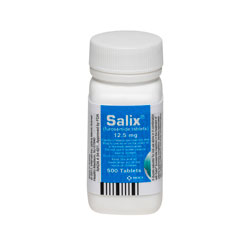Salix (Furosemide)
Veterinarian Prescription (Rx) Required
Free Shipping on orders over $75
Description
Salix® is for the treatment of edema associated with cardiac insufficiency and acute non-inflammatory tissue edema in dogs and cats.Key Benefits
- Treats excessive fluid accumulation and swelling caused by heart failure and other health problems
- Easy to administer
- Sold as 10 mg/ml 60 ml bottle oral solution or by the tablet for dogs and cats and as a 50 mg/ml injectable solution for horses, cats, and dogs
How It Works
Furosemide is a potent diuretic which works by blocking the absorption of salt and fluid in the kidney tubules causing an increase in urine output.
Indications
For the treatment of edema associated with cardiac insufficiency and acute non-inflammatory tissue edema in dogs, cats and horses.
Directions
The usual dosage of Salix is 1 to 2 mg/lb. body weight (approximately 2.5 to 5 mg/kg). The lower dosage is suggested for cats. Administer once or twice daily at 6 to 8 hour intervals either orally, intravenously, or intramuscularly. A prompt diuresis usually ensues from the initial treatment. Diuresis may be initiated by the parenteral administration of Salix injection and then maintained by oral administration.
The dosage should be adjusted to the individual's response. In severe edematous or refractory cases, the dose may be doubled or increased by increments of 1 mg per pound body weight. The established effective dose should be administered once or twice daily. The daily schedule of administration can be timed to control the period of micturition for the convenience of the client or veterinarian.
Mobilization of the edema may be most efficiently and safely accomplished by utilizing an intermittent daily dosage schedule, i.e. every other day or 2 to 4 consecutive days weekly.
Diuretic therapy should be discontinued after reduction of the edema, or maintained after determining a carefully programmed dosage schedule to prevent recurrence of edema. For long-term treatment, the dose can generally be lowered after the edema has once been reduced. Re-examination and consultations with client will enhance the establishment of a satisfactorily programmed dosage schedule. Clinical examination and serum BUN, CO2 and electrolyte determinations should be performed during the early period of therapy and periodically thereafter, especially in refractory cases. Abnormalities should be corrected or the drug temporarily withdrawn.
ORAL
Dog & Cat - One-half to one 50 mg scored tablet per 25 pounds body weight.
One 12.5 mg tablet per 5 to 10 pounds body weight.
Administer once or twice daily, permitting a 6 to 8 hour interval between treatments. In refractory or severe edematous cases, the dosage may be doubled or increased by increments of 1 mg per pound body weight as recommended in preceding paragraphs, "Dosage and Administration".
PARENTERAL
Dog & Cat - Administer intramuscularly or intravenously 1/4 to 1/2 mL per 10 pounds body weight.
Administer once or twice daily, permitting a 6 to 8 hour interval between treatments. In refractory or severe edematous cases, the dosage may be doubled or increased by increments of 1 mg per pound body weight as recommended in preceding paragraphs, "Dosage and Administration".
Horse - The individual dose is 250 to 500 mg (5 to 10 mL) administered intramuscularly or intravenously once or twice daily at 6 to 8 hour intervals until desired results are achieved. The veterinarian should evaluate the degree of edema present and adjust dosage schedule accordingly. Do not use in horses intended for human consumption.
Cattle - The individual dose administered intramuscularly or intravenously is 500 mg (10 mL) once daily or 250 mg (5 mL) twice daily at 12 hour intervals. Treatment not to exceed 48 hours post parturition.
Milk taken from animals during treatment and for 48 hours (four milkings) after the last treatment must not be used for food. Cattle must not be slaughtered for food within 48 hours following last treatment.
Federal law restricts this drug to use by or on the order of a licensed veterinarian.
Caution
Federal law restricts this drug to use by or on the order of a licensed veterinarian. See package labeling for storage conditions.
Contraindications: Precautions
Salix is a highly effective diuretic-saluretic which if given in excessive amounts may result in dehydration and electrolyte imbalance. Therefore, the dosage and schedule may have to be adjusted to the patient's needs. The animal should be observed for early signs of electrolyte imbalance, and corrective measures administered. Early signs of electrolyte imbalance are: increased thirst, lethargy, drowsiness or restlessness, fatigue, oliguria, gastro-intestinal disturbances and tachycardia.
Special attention should be given to potassium levels.
Salix may lower serum calcium levels and cause tetany in rare cases of animals having an existing hypocalcemic tendency.
Although diabetes mellitus is a rarely reported disease in animals, active or latent diabetes mellitus may on rare occasions be exacerbated by Salix. While it has not been reported in animals the use of high doses of salicylates, as in rheumatic diseases, in conjunction with Salix may result in salicylate toxicity because of competition for renal excretory sites.
Transient loss of auditory capacity has been experimentally produced in cats following intravenous injection of excessive doses of Salix at a very rapid rate.
Electrolyte balance should be monitored prior to surgery in patients receiving Salix. Imbalances must be corrected by administration of suitable fluid therapy.
Salix is contraindicated in anuria. Therapy should be discontinued in cases of progressive renal disease if increasing azotemia and oliguria occur during the treatment. Sudden alterations of fluid and electrolyte imbalance in an animal with cirrhosis may precipitate hepatic coma, therefore observation during period of therapy is necessary. In hepatic coma and in states of electrolyte depletion, therapy should not be instituted until the basic condition is improved or corrected. Potassium supplementation may be necessary in cases routinely treated with potassium-depleting steroids.
Important Safety Information
Salix is a highly effective diuretic and if given in excessive amounts as with any diuretic may lead to excessive diuresis which could result in electrolyte imbalance, dehydration and reduction of plasma volume enhancing the risk of circulatory collapse, thrombosis, and embolism. Therefore, the animal should be observed for early signs of fluid depletion with electrolyte imbalance, and corrective measures administered. Excessive loss of potassium in patients receiving digitalis or its glycosides may precipitate digitalis toxicity. Caution should be exercised in animals administered potassium-depleting steroids. It is important to correct potassium deficiency with dietary supplementation. Caution should be exercised in prescribing enteric-coated potassium tablets. Consult your veterinarian and see package insert for full information regarding contraindications, warnings, and precautions.
Salix is a registered trademark of Intervet Inc., d/b/a Merck Animal Health, a subsidiary of Merck & Co. Inc.










